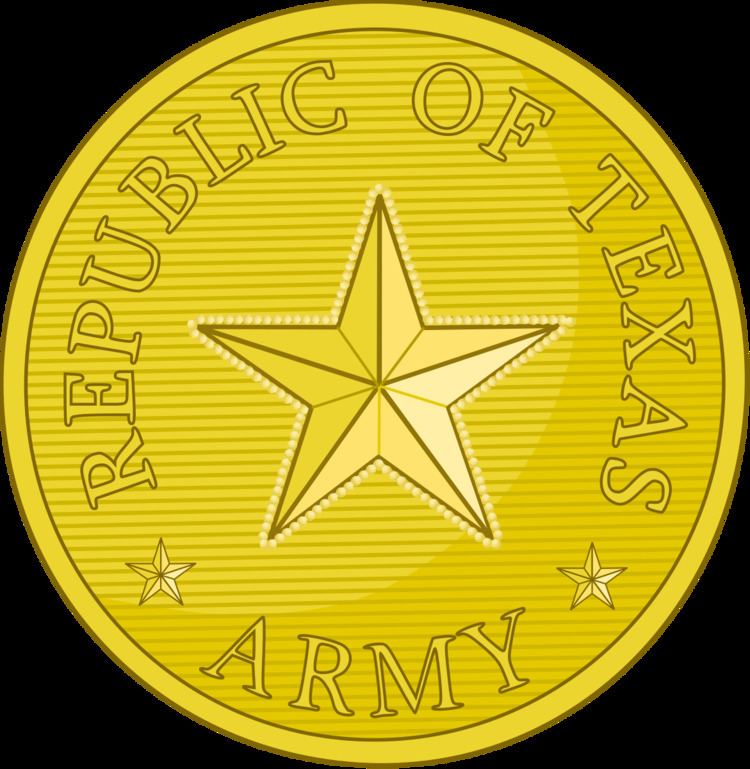Size 465–3,600 | Type Army | |
 | ||
Active October 2, 1835–February 19, 1846 Role Ground-based military warfare | ||
The Army of the Republic of Texas was the land-based component of the armed forces for the Republic of Texas. It directly descended from the Texian Army, which was established on October 2, 1835, to fight for independence from Mexico in the Texas Revolution. The army was provisionally formed from the Consultation in November 1835, and officially established on September 5, 1836, from Article II, Section 5 of the Constitution of the Republic of Texas. After Texas' annexation by the United States, the Army of the Republic of Texas was merged into the United States Army. Today, the 141st Infantry Regiment trace their lineage back to the Texas Revolution.
Contents
History
The regular division of the Army was officially established on December 12, 1835. Any man who enlisted in the regular division would receive $24 in cash, the rights to 800 acres (320 ha) of land, and instant Texan citizenship. Those who joined the volunteer auxiliary corps would receive 640 acres (260 ha) of land if they served two years, while those who served 1 year would receive 320 acres (130 ha). A month later the establishment of a Legion of Cavalry would be authorized.
The commander of the regular forces, Sam Houston, called for 5,000 men to enlist in the regular army but had difficulty convincing men to join. Many of the arrivals from the United States did not want to be under a more strict military control, and instead informally joined the volunteer units that had gathered in other parts of Texas. These volunteer soldiers were in many cases more impassioned than the Texas settlers. Although the provisional Texas government was still debating whether the troops were fighting for independence or for separate statehood, on December 20, 1835, the Texian garrison at Goliad voted unanimously to issue a proclamation of independence, stating "that the former province and department of Texas is, and of right ought to be, a free, sovereign and independent state".
The provisional government had originally placed Houston in charge of the regular forces, but in December the council gave secret orders to James Fannin, Frank W. Johnson, and Dr. James Grant to prepare forces to invade Mexico. Houston was then ordered to travel to East Texas to broker a treaty that would allow the Cherokee to remain neutral in the conflict. Johnson and Grant gathered 300 of the 400 men garrisoned in Bexar and left to prepare for the invasion.
The government was woefully short of funds. On January 6, 1836, Colonel James C. Neill, commander of the remaining 100 troops in Bexar, wrote to the council: " there has ever been a dollar here I have no knowledge of it. The clothing sent here by the aid and patriotic exertions of the honorable Council, was taken from us by arbitrary measures of Johnson and Grant, taken from men who endured all the hardships of winter and who were not even sufficiently clad for summer, many of them having but one blanket and one shirt, and what was intended for them given away to men some of whom had not been in the army more than four days, and many not exceeding two weeks."
For the next several months it was unclear who was in charge of the Texian army—Fannin, Johnson, Grant, or Houston. On January 10, Johnson issued a call to form a Federal Volunteer Army of Texas which would march on Matamoros during the Matamoros Expedition.
Organization
The first regular army was officially created and organized by the Consultation in 1835, and was largely based on that of the United States Army. The Consultation called for the most senior officer known as the commander-in-chief with the rank of major general to command the regular army and the volunteers with the power to appoint one adjutant general, one quartermaster general, one paymaster general, one surgeon general and four aides-de-camp. MG Sam Houston was elected as the inaugural commander-in-chief by representatives of the Consultation of 1835 on November 12, 1835. Additionally, many of the officers were elected directly by the members of the Consultation.
Unit structure of the regular army called for two regiments—an infantry regiment and an artillery regiment which each consisted of two battalions, which had five companies each. A separate Corps of Rangers as a battalion was set-up to have three companies. Initially, the army did not include a cavalry, when established in November 1835, but in December, it was added, and known as the Legion of Cavalry. The Legion of Cavalry was composed of two squadrons that were made of three companies each. In addition to the regular army and volunteer militia (known as the "Army of the People") a Volunteer Auxiliary Corps was established to act as a military reserve force.
Although much of the army remained the same on paper, due to the ratification of the Constitution of the Republic of Texas in September 1836, the organizational structure of the army was modified. The commander-in-chief of the army became the President of the Republic of Texas, but his command authority could not be exercised without the authority of the Congress of the Republic of Texas.
Personnel
Rank structure in the Army of the Republic of Texas was largely based on that of the United States Army.
Commanders
Until September 1836, the commanding officer of the army was known as the "commander-in-chief". Following the ratification of the Constitution of 1836, the title was assumed by the President of the Republic of Texas.
